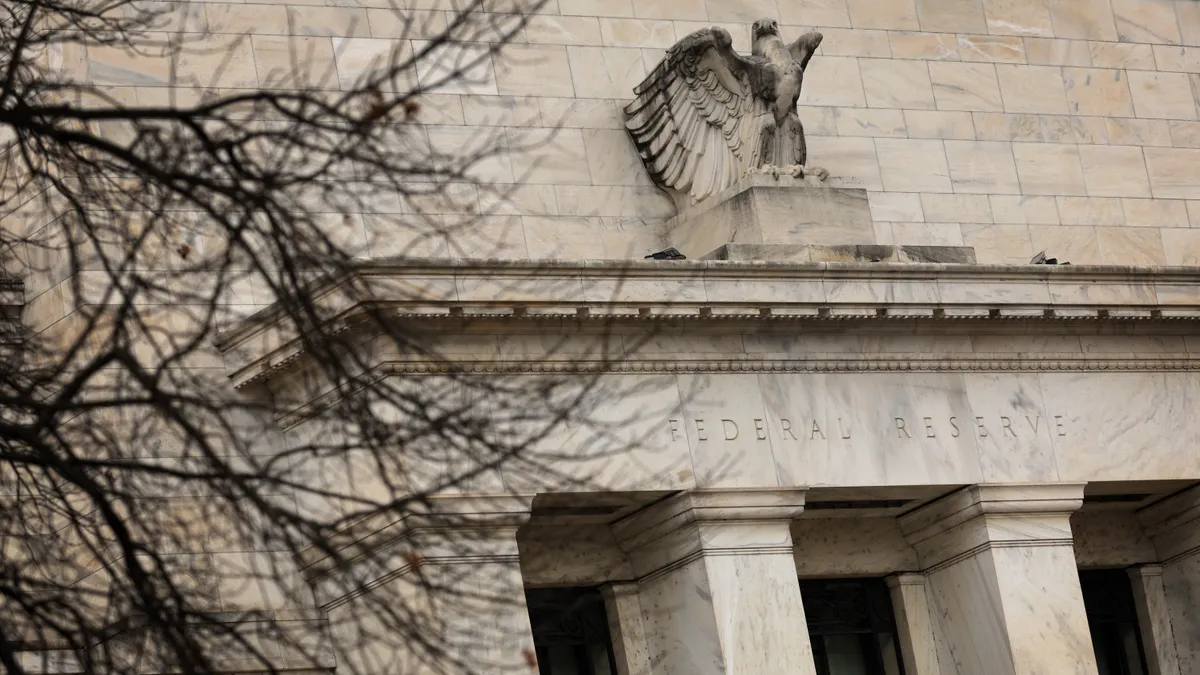Dive Brief:
- Federal Reserve policymakers on Wednesday will likely press on with their fight against high inflation and raise the main interest rate by a quarter percentage point despite the risk of fueling banking turmoil, according to economists and Fed-funds futures.
- “Looking at where markets are right now today, I think the most likely thing they do is hike by 25” basis points, Pantheon Macroeconomics Chief Economist Ian Shepherdson said, adding that he believed “they shouldn’t hike this week because I think they should follow the principle of first doing no harm.”
- Futures traders Tuesday saw 87% odds that the Fed will raise the main interest rate by a quarter point as bank stocks recovered and Treasury Secretary Janet Yellen, seeking to restore confidence following the collapse of Signature Bank and Silicon Valley Bank, said the government could protect depositors at other banks if needed.
Dive Insight:
Fed Chair Jerome Powell in congressional testimony on March 8 suggested that the central bank may raise the federal funds rate this year more than anticipated, citing persistently high inflation and strength in the labor market, consumer spending and manufacturing.
After Powell’s comments Fed-funds futures signaled 78% odds that the central bank will raise the main interest rate by a half point, according to the CME FedWatch Tool.
Bank failures in mid-March all but eliminated expectations that the Fed will redouble its most aggressive tightening in monetary policy in 40 years. Credit availability will likely fall in coming months, complementing Fed efforts to cool the economy and reduce price pressures, according to economists.
“The creation of credit is really going to slow down while we go through this painful process of everyone looking at all the different financial institutions and figuring out who’s in a good position and who might not be,” U.S. Chamber of Commerce Chief Economist Curtis Dubay said.
“The uncertainty that arises from that and the actual reduction in credit will likely push the growth lower and could finally tip us into that long awaited recession,” Dubay said during a March 17 webinar.
Since the start of monetary policy tightening in March 2022, Powell and other Fed officials have expressed confidence that they can slow growth and push down inflation without causing a recession. Although easing during the past year, inflation persists well above the Fed’s 2% target.
The core Consumer Price Index, a measure of inflation excluding volatile food and energy prices, rose 0.5% in February, the most in five months, and 5.5% compared with a year earlier.
Shelter prices increased 0.8 percentage points last month, the most of any category in Labor Department data. Such “sticky” prices — including medical care, education and personal care services — are slow to change and a particular concern to central bankers.
The Atlanta Fed’s “sticky price” CPI increased 6.8% last month on an annual basis after a 6.3% gain in January, aligning with the rise in core CPI.
“Sticky inflation momentum revealed in the most recent price and labor market data suggests that tamping down inflation will remain the focus for U.S. monetary policy,” Moody’s Investors Service analysts said in a report.
“The Fed will draw a distinction between financial stability measures and monetary policy measures,” Moody’s analysts wrote in a report. They predicted that the Fed will increase the federal funds rate by a quarter point on Wednesday and in meetings planned for May and June.
The central bank may not need to increase rates further — if at all — as credit standards tighten, wage pressures decline, supply chains loosen, and price gains for food, oil and rent ease, Shepherdson said during a webinar on Monday.
“All five drivers of the inflation overshoot are reversing, and will ensure that inflation falls for the foreseeable future,” he said.












